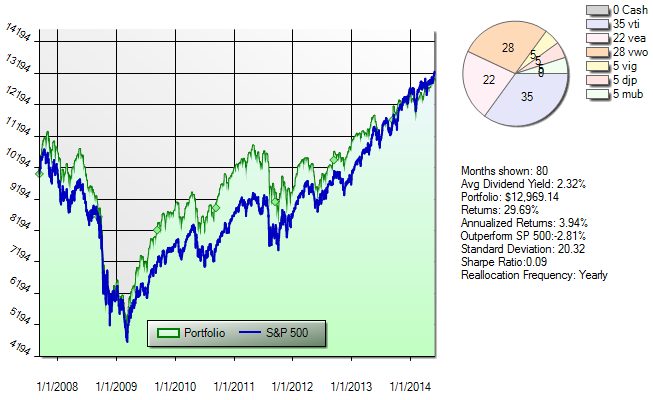 investment services”. Automated investment services are platforms that automate your investment portfolio and try to help you reduce fees, increase efficiencies and streamline your process through a simple computerized interface. Here’s a look at 4 primary benefits and 4 potential problems to help you decide if such a service is for you.
investment services”. Automated investment services are platforms that automate your investment portfolio and try to help you reduce fees, increase efficiencies and streamline your process through a simple computerized interface. Here’s a look at 4 primary benefits and 4 potential problems to help you decide if such a service is for you.
The following article is presented by Lorimer Wilson, editor of www.munKNEE.com (Your Key to Making Money!) and the FREE Market Intelligence Report newsletter (sample here) and has been edited, abridged and/or reformatted (some sub-titles and bold/italics emphases) for the sake of clarity and brevity to ensure a fast and easy read. This paragraph must be included in any article re-posting to avoid copyright infringement.
Automated investment advisory firms will drive down broad fees as they undercut the traditional advisory business model through their low cost platform. This should substantially reduce the fees clients pay on average. This is fantastic news as I’ve long believed that investment advisory services are overpriced.
The ability to automate your advisory services means you don’t necessarily need a person to help you put together a financial plan and this means that the rest of the advisory business will have increasing trouble proving their value. This means that sub-par advisors are likely to be driven out of the business over time as high fee structures and the lack of a value proposition renders them void.
Combining robo advisory services…with real personal advisory services, as Vanguard is now doing, is a sign that the robots can work with the machines. It actually discredits the pure robo advisory structure to a large degree, which I think is the right blend.
Another interesting example is WealthFront’s Single Stock Diversification Program which helps investors in public companies better diversify their portfolios. This can be a valuable service for someone who isn’t interested in paying high fees to have a major investment bank manage this service for you…
On the whole, the above are incredibly positive developments for the advisory business and consumers. In short, automated advisory is changing the advisory landscape and forcing the entire industry to adapt and evolve with the times.
Technology has always been problematic for financial advisory in several ways so let’s also look at some of the potential problems here:
You input your information, they output the data. It’s all automated. They often don’t know you, they don’t know your feelings, your family, your personal needs, goals, precise risk tolerance, etc. This is a big problem from a financial planning and portfolio construction perspective. It’s great to cut fees, but we shouldn’t be willing to reduce the quality of our financial plans just for a low fee advisory service. The pure robo advisor is a step backwards in this sense. It puts costs ahead of quality.
In WealthFront’s aggressive output, the high risk investor is invested in a portfolio that results in a 90/5/5 portfolio (stocks/bonds/commodities). If you run this portfolio against a simple 3 fund allocation using the Vanguard Total Stock Index, Vanguard Total Bond Index and the GSCI Commodity Index at a similar 90/5/5 weighting, the numbers show that their “optimal” allocation is actually leading to portfolio degradation. The robo advisor output increases your risk and reduces your return by generating a 20.32 standard deviation, annualized returns of 3.94% and a zero Sharpe Ratio. The simple 3 fund alternative, on the other hand, generates a 6.47% return, 18.15 standard deviation and 0.36 Sharpe ratio over the same period. In other words, this portfolio takes more risk, generates a lower return AND charges you a premium for it.In the case of Betterment...when properly benchmarked and risk adjusted, there also was no value added over a standard low fee aggregate index.
(Figure 1 – WealthFront’s Aggressive portfolio vs the S&P 500)
The most conservative output generates the same results. On WealthFront, this “risk profile” outputs a 37/58/5 allocation (stocks/bonds/commodities) creating a portfolio that generates a 4.98% return, 9.0 standard deviation and 0.38 Sharpe Ratio over the most recent market cycle. If you compare this to a simple cookie cutter 3 fund index using the Vanguard Total Stock Index, Vanguard Total Bond and GSCI Commodity Index you again see portfolio degradation. In this case, the simple 3 fund portfolio generates a 5.77% return, 8.08 standard deviation and a 0.7 Sharpe Ratio. The robo advisor is trying to sell the concept of “diversification” by picking funds more specifically than a simple broad index and in doing so they’re actually creating a portfolio that hurts your results.
What’s going on here is that the Automated Services are:
- actually “picking” funds inside of aggregates (If they were true adherents to Burton Malkiel’s Random Walk theory they’d recommend the Vanguard Total Stock Index and the Vanguard Total Bond Aggregate, apply the proper risk tolerance and weightings and call it a day. Of course, if they did this most of their clients would turn around and ask why they need the robo advisor middleman when Vanguard can handle the two funds for them without the added fee) such as a municipal bond holding for the bond position, calling it “optimal allocation” and then underperforming the aggregate – which is exactly what a pure indexer would expect,
- basically selling a tactical asset allocation approach as being better than a true indexing approach and then calling it a true indexing approach as part of their marketing plan and
- then they benchmark it relative to a high fee active manager and call their portfolio “optimal” or claim it generates “additional returns”. I don’t like that one bit.
4) Beware of the Robo Advisor “additional return” claims.
I found it quite alarming how some of the robo advisors calculated their “additional returns” they advertise. You can see these claims on the front of just about any of their websites. They generally claim anywhere from 4-5% in “additional” gains.
- First of all, these firms are using index funds to construct portfolios so the claim of 4-5% additional returns should be an instant red flag. The S&P 500 has averaged a real return of about 6% since 1925. No index fund implementation is coming close to DOUBLING that figure no matter how fancy their algorithms are so some basic common sense tells us that these “additional return” claims look dubious.
- In establishing the claim of “additional returns” the Robo Advisors misrepresent their benchmarks by comparing their allocations to active mutual funds or by citing studies using active management. THIS IS NOT PROPERLY BENCHMARKED. Of course, if you compare an index fund to an active mutual fund charging 1-2% per year then you can claim “additional” returns, but I have never seen anyone benchmark their portfolios relative to an active manager. The proper benchmark is a highly correlated passive index of equal weightings but the Robo Advisors don’t do that comparison because then you’d see the results I posted above, which actually show that their results are worse than Vanguard’s most basic allocations.
Let’s look at this in more detail though. What you see on the Robo Advisor sites are claims that look something like the following:
Get Additional Returns with Robo Advisor XYZ:
- Passive Investing +1.25%
- Index Funds Over Mutual Funds +2.1%
- Optimal/Better Diversification +0.5-1.4%
- Automated Rebalancing +0.45%
- Tax Aware Allocation +0.6%
- Tax Loss Harvesting +1%
- Better Behavior +1.25%
Total Additional Returns: 4-5%
This is well constructed marketing and little more:
- Passive investing and avoiding high fee mutual funds will likely increase the return for the average investor. No one benchmarks portfolios relative to a high fee active manager so let’s just ignore claims about generating 1-2% increased returns from this.
- The optimal allocation claims are dubious as I showed above and it’s probable that this figure is not just overstated, but potentially NEGATIVE.
- Any automated re-balancing is pretty standard and not necessarily a value add.
- The “tax aware” allocation is something anyone can find on the internet via a simple Google search.
- The value of the tax loss harvesting is probably overstated.
- The claim about “better behavior” assumes an active portfolio management style.
In other words, the 4-5% “additional return” claim is only true if:
- you’re doing just about everything wrong with your portfolio,
- you don’t have an advisor of any type or
- you don’t have access to the vast online resources for do-it-yourselfers.
Conclusion
There’s a lot of positives that are coming out of the Robo Advisor disruption. I hope that doesn’t get lost in this message. We’re likely to see:
- increased automation,
- lower fees and
- fewer suboptimal advisors.
That’s fantastic news, but I think you have to also approach their services with some skepticism.
- will never replace a good financial planner because your financial plan can’t be whittled down to a set of numbers without some personal analysis. There’s simply no avoiding the human element there. It takes more than an algorithm to understand a human being’s mind and feelings,
- overstates the benefits, in my opinion. I would not expect these services to generate “additional returns” relative to a well constructed passive index fund strategy. In fact, they’re very likely to underperform after their extra fees.
I would follow a basic rule of thumb here.
- If you have a small portfolio or rather basic financial needs then the Robo Advisor can be a fine way to automate a process and better organize your finances. Smaller portfolios generally don’t pay any fees using these services so that’s a good fit.
- If, however, you’re a wealthy investor with sophisticated finances then I’d be hesitant to skimp on the quality of service in favor of what appears to be a low fee marketing pitch and,
- if you’re a sophisticated do-it-yourselfer then there’s probably not much a Robo Advisor can do that you can’t already do at Vanguard for a low fee on your own. Paying a management fee for a suboptimal buy and hold portfolio just doesn’t make much sense.
Personally, I am always in favor of a DIY approach and that’s what I try to help people better achieve through my business and Portfolio Review process, but I understand that it’s not for everyone and depending on your personal needs a Robo Advisor could be appropriate for you.
Let’s keep things in perspective here:
- Paying a Robo Advisor 15-25 bps for a simple, automated portfolio approach is 10X better than paying an actively managed closet index fund manager ON TOP of wirehouse style brokerage fees so let’s all applaud the improvement in the industry.
- Unfortunately, however, I think there’s a lot of work to be done on improving the Robo Advisor model before it becomes useful to high net worth and more sophisticated clients. Vanguard seems to be on to something with their direction and I think the pure Robo Advisor firms are going to have to realize that people are more important than robots in financial management.
As of right now, there are simply too many problems in the underlying business model and portfolio construction process to be useful for anyone with a moderately high level of sophistication and planning needs so I am extremely hesitant to recommend these services over a reasonably priced alternative.
Editor’s Note: The author’s views and conclusions in the above article are unaltered and no personal comments have been included to maintain the integrity of the original post. Furthermore, the views, conclusions and any recommendations offered in this article are not to be construed as an endorsement of such by the editor.
*http://pragcap.com/should-you-use-an-automated-investment-service
Related Articles:
1. Self-manage Your Portfolio? Think Again! Here Are 10 Reasons You NEED a Financial Advisor
Irrespective of any active v. passive investing debate, good advisors are an absolute necessity. Here’s my top 10 list of reasons why.
 munKNEE.com Your Key to Making Money
munKNEE.com Your Key to Making Money



